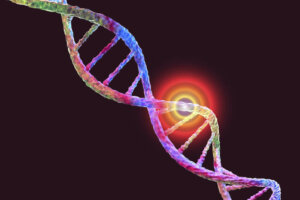Risk Factors and Causes of Breast Cancer

According to estimates by the American Cancer Society, there’s a probability that 1 in 8 women will develop breast cancer at some point in their lives. That’s 13% of the population. The disease hasn’t been fully understood, although there are several hypotheses for the causes of breast cancer.
Along with the causes we find the risk factors, which we can divide into preventable and non-preventable. Genetic, environmental, hormonal and natural factors have been identified as the culprits, although practice indicates that the mechanisms don’t always follow these rules.
Main causes of breast cancer
Breast cancer occurs when breast cells begin to develop abnormally, grow, and divide. Why this happens is still a mystery, as it happens with other types of cancer.
This is due to the fact that many patients develop the pathology without there being risk factors or apparent delimited causes. Similarly, women who seem to have so many potential catalysts never get to develop it. Research points to a multifactorial explanation in which the following elements converge.
Genetic predisposition
The possible relationship between genes and breast cancer has been studied in depth. According to some estimates, between 5 and 10% of cases develop due to such a predisposition.
The genes listed are called breast cancer gene 1 (or BRCA1) and breast cancer gene 2 (or BRCA2). Other genes have also been identified, although these are the most important ones.
Because of this, the chances of developing breast cancer (or other types of cancer) increase if there’s a family history of the disease. It’s common for specialists to perform genetic tests to identify the presence of these genes in patients with parents or grandparents with cancer. This predisposition has also been linked to ovarian cancer.
Hormonal imbalances

Another cause of breast cancer, as the evidence indicates, is hormonal imbalances. This would explain, according to some studies, why some of the diagnoses occur during women’s most acute reproductive years. Imbalances can be endogenous (internal) or external.
Among the external hormonal imbalances, we highlight the therapies implemented after menopause and the intake of oral contraceptives. Regarding the latter, current research has shown that prolonged intake increases the chances of developing breast cancer compared to women who have never used them or only for short periods.
Development of breast diseases
Some breast diseases aren’t related, at least not directly, to breast cancer. For example, women who have suffered from atypical hyperplasia or lobular carcinoma in situ are more likely to develop the disease in the future.
Those who have suffered from breast, ovarian or other types of cancer are also more likely to have the disease, so supervision with the specialist is recommended in order to detect possible recurrences.
Age
A functional relationship between cancer and aging has been demonstrated, and of course, the breast variant is no exception. We know that the chances of getting breast cancer increase after the age of 40.
However, after menopause, the incidence decreases in comparison. The reason isn’t yet clear, although the development of the disease from this point on is slower and less aggressive.
Although it varies from country to country, the average age for breast cancer diagnosis is between 50 and 60 years of age. The reason is believed to be hormonal changes, the accumulation of risk factors, and alterations in the immune system.
These are the main causes of cancer. Some of the diagnoses can be explained with their help, but not always. A woman, and, to a lesser extent, a man, can contract the disease without a solid reason being identified. Sometimes, however, the reason can be found in risk factors.
Risk factors for breast cancer
The risk factors for breast cancer have been studied in depth by experts. In general, they’re usually divided into factors that can’t be prevented (intrinsic/inherent) and factors that can be prevented (extrinsic). Bearing this in mind. we’ll now look at the most frequent:
Inherent/intrinsic risk factors
These are the ones that have some type of irreversible natural predisposition or conditioning. Having one or more of these doesn’t mean that cancer will develop, just that the chances are slightly higher. Some of the most important are the following:
- Being a woman: Although it’s taken for granted that it’s an exclusively female disease, in reality experts estimate that 1% of breast cancer diagnosed annually corresponds to men. In contrast, women are far more likely to develop the disease in percentage terms.
- Early menarche: It has long been known that the early onset of ovulatory cycles, initially before the age of 12, is related to breast cancer.
- Late menopause: In the same way, late menopause, that is, after 55 years of age, also increases the chances of developing the disease.
- Breast density: The evidence suggests that the size of the breasts is related to the appearance of cancer at some point in life.
- Exposure to DES: Diethylstilbestrol is a drug that has been used to prevent miscarriages in several countries. Today we know that prenatal exposure to it is a risk factor for the development of this type of cancer.
Extrinsic risk factors

In this category, we find habits or lifestyles that can condition people to suffer from this type of cancer. Among the most common we highlight the following:
- Uncontrolled alcohol consumption
- Tobacco intake
- Unbalanced diet
- Absence of physical activity
- Intake of some medications (especially those that cause some hormonal alteration)
- Pregnancy after 30 years or absence of it. The incidence of reproductive factors with breast cancer is documented.
- Obesity
- Psychological disorders such as stress
- Abuse of radiation exposure, either at work or through medical examinations
As you can see, these are elements that can be changed. However, doing so doesn’t completely prevent cancer, and the WHO suggests that the chances can be reduced by up to 30%.
On the contrary, some positive patterns have been identified that counteract the possible causes of breast cancer. One of the most important is prolonged breastfeeding (beneficial for both mother and baby). Also, a general change in lifestyle towards healthier habits is positive for this and other types of cancer.
According to estimates by the American Cancer Society, there’s a probability that 1 in 8 women will develop breast cancer at some point in their lives. That’s 13% of the population. The disease hasn’t been fully understood, although there are several hypotheses for the causes of breast cancer.
Along with the causes we find the risk factors, which we can divide into preventable and non-preventable. Genetic, environmental, hormonal and natural factors have been identified as the culprits, although practice indicates that the mechanisms don’t always follow these rules.
Main causes of breast cancer
Breast cancer occurs when breast cells begin to develop abnormally, grow, and divide. Why this happens is still a mystery, as it happens with other types of cancer.
This is due to the fact that many patients develop the pathology without there being risk factors or apparent delimited causes. Similarly, women who seem to have so many potential catalysts never get to develop it. Research points to a multifactorial explanation in which the following elements converge.
Genetic predisposition
The possible relationship between genes and breast cancer has been studied in depth. According to some estimates, between 5 and 10% of cases develop due to such a predisposition.
The genes listed are called breast cancer gene 1 (or BRCA1) and breast cancer gene 2 (or BRCA2). Other genes have also been identified, although these are the most important ones.
Because of this, the chances of developing breast cancer (or other types of cancer) increase if there’s a family history of the disease. It’s common for specialists to perform genetic tests to identify the presence of these genes in patients with parents or grandparents with cancer. This predisposition has also been linked to ovarian cancer.
Hormonal imbalances

Another cause of breast cancer, as the evidence indicates, is hormonal imbalances. This would explain, according to some studies, why some of the diagnoses occur during women’s most acute reproductive years. Imbalances can be endogenous (internal) or external.
Among the external hormonal imbalances, we highlight the therapies implemented after menopause and the intake of oral contraceptives. Regarding the latter, current research has shown that prolonged intake increases the chances of developing breast cancer compared to women who have never used them or only for short periods.
Development of breast diseases
Some breast diseases aren’t related, at least not directly, to breast cancer. For example, women who have suffered from atypical hyperplasia or lobular carcinoma in situ are more likely to develop the disease in the future.
Those who have suffered from breast, ovarian or other types of cancer are also more likely to have the disease, so supervision with the specialist is recommended in order to detect possible recurrences.
Age
A functional relationship between cancer and aging has been demonstrated, and of course, the breast variant is no exception. We know that the chances of getting breast cancer increase after the age of 40.
However, after menopause, the incidence decreases in comparison. The reason isn’t yet clear, although the development of the disease from this point on is slower and less aggressive.
Although it varies from country to country, the average age for breast cancer diagnosis is between 50 and 60 years of age. The reason is believed to be hormonal changes, the accumulation of risk factors, and alterations in the immune system.
These are the main causes of cancer. Some of the diagnoses can be explained with their help, but not always. A woman, and, to a lesser extent, a man, can contract the disease without a solid reason being identified. Sometimes, however, the reason can be found in risk factors.
Risk factors for breast cancer
The risk factors for breast cancer have been studied in depth by experts. In general, they’re usually divided into factors that can’t be prevented (intrinsic/inherent) and factors that can be prevented (extrinsic). Bearing this in mind. we’ll now look at the most frequent:
Inherent/intrinsic risk factors
These are the ones that have some type of irreversible natural predisposition or conditioning. Having one or more of these doesn’t mean that cancer will develop, just that the chances are slightly higher. Some of the most important are the following:
- Being a woman: Although it’s taken for granted that it’s an exclusively female disease, in reality experts estimate that 1% of breast cancer diagnosed annually corresponds to men. In contrast, women are far more likely to develop the disease in percentage terms.
- Early menarche: It has long been known that the early onset of ovulatory cycles, initially before the age of 12, is related to breast cancer.
- Late menopause: In the same way, late menopause, that is, after 55 years of age, also increases the chances of developing the disease.
- Breast density: The evidence suggests that the size of the breasts is related to the appearance of cancer at some point in life.
- Exposure to DES: Diethylstilbestrol is a drug that has been used to prevent miscarriages in several countries. Today we know that prenatal exposure to it is a risk factor for the development of this type of cancer.
Extrinsic risk factors

In this category, we find habits or lifestyles that can condition people to suffer from this type of cancer. Among the most common we highlight the following:
- Uncontrolled alcohol consumption
- Tobacco intake
- Unbalanced diet
- Absence of physical activity
- Intake of some medications (especially those that cause some hormonal alteration)
- Pregnancy after 30 years or absence of it. The incidence of reproductive factors with breast cancer is documented.
- Obesity
- Psychological disorders such as stress
- Abuse of radiation exposure, either at work or through medical examinations
As you can see, these are elements that can be changed. However, doing so doesn’t completely prevent cancer, and the WHO suggests that the chances can be reduced by up to 30%.
On the contrary, some positive patterns have been identified that counteract the possible causes of breast cancer. One of the most important is prolonged breastfeeding (beneficial for both mother and baby). Also, a general change in lifestyle towards healthier habits is positive for this and other types of cancer.
- Apter, D. A. N., & VIHKO, R. Early menarche, a risk factor for breast cancer, indicates early onset of ovulatory cycles. The Journal of Clinical Endocrinology & Metabolism. 1983; 57(1): 82-86.
- Balducci, L., & Extermann, M. Cancer and aging: an evolving panorama. Hematology/oncology clinics of North America. 2000; 14(1): 1-16.
- Benz, C. C. Impact of aging on the biology of breast cancer. Critical reviews in oncology/hematology. 2008; 66(1): 65-74.
- ESHRE Capri Workshop Group. Hormones and breast cancer. Human Reproduction Update. 2004; 10(4): 281-293.
- Hulka, B. S., & Moorman, P. G. Reprint of Breast cancer: hormones and other risk factors. Maturitas. 2008; 61(1-2): 203-213.
- Kamińska, M., Ciszewski, T., Łopacka-Szatan, K., Miotła, P., & Starosławska, E. Breast cancer risk factors. Przeglad menopauzalny= Menopause review. 2015; 14(3): 196.
- Kelsey, J. L., Gammon, M. D., & John, E. M. Reproductive factors and breast cancer. Epidemiologic reviews. 1993; 15(1): 36-47.
- MacMahon, B. Epidemiology and the causes of breast cancer. International journal of cancer. 2006; 118(10): 2373-2378.
- Martínez-Tlahuel, J. L., Arce, C., & Lara, F. Cáncer de mama en el hombre. Cancerología. 2006; 1(1), 201-10.
- Mørch, L. S., Skovlund, C. W., Hannaford, P. C., Iversen, L., Fielding, S., & Lidegaard, Ø. Contemporary hormonal contraception and the risk of breast cancer. New England Journal of Medicine. 2017; 377(23): 2228-2239.
- Nathanson, K. N., Wooster, R., & Weber, B. L. Breast cancer genetics: what we know and what we need. Nature medicine. 2001; 7(5): 552-556.
- Palmer, J. R., Wise, L. A., Hatch, E. E., Troisi, R., Titus-Ernstoff, L., Strohsnitter, W., … & Hoover, R. N. Prenatal diethylstilbestrol exposure and risk of breast cancer. Cancer Epidemiology and Prevention Biomarkers. 2006; 15(8): 1509-1514.
- Stephens, P. J., Tarpey, P. S., Davies, H., Van Loo, P., Greenman, C., Wedge, D. C., … & Stratton, M. R. The landscape of cancer genes and mutational processes in breast cancer. Nature. 2012; 486(7403): 400-404.
- Wang, A. T., Vachon, C. M., Brandt, K. R., & Ghosh, K. Breast density and breast cancer risk: a practical review. In Mayo Clinic Proceedings. 2014; Vol. 89, No. 4: 548-557.
Este texto se ofrece únicamente con propósitos informativos y no reemplaza la consulta con un profesional. Ante dudas, consulta a tu especialista.







